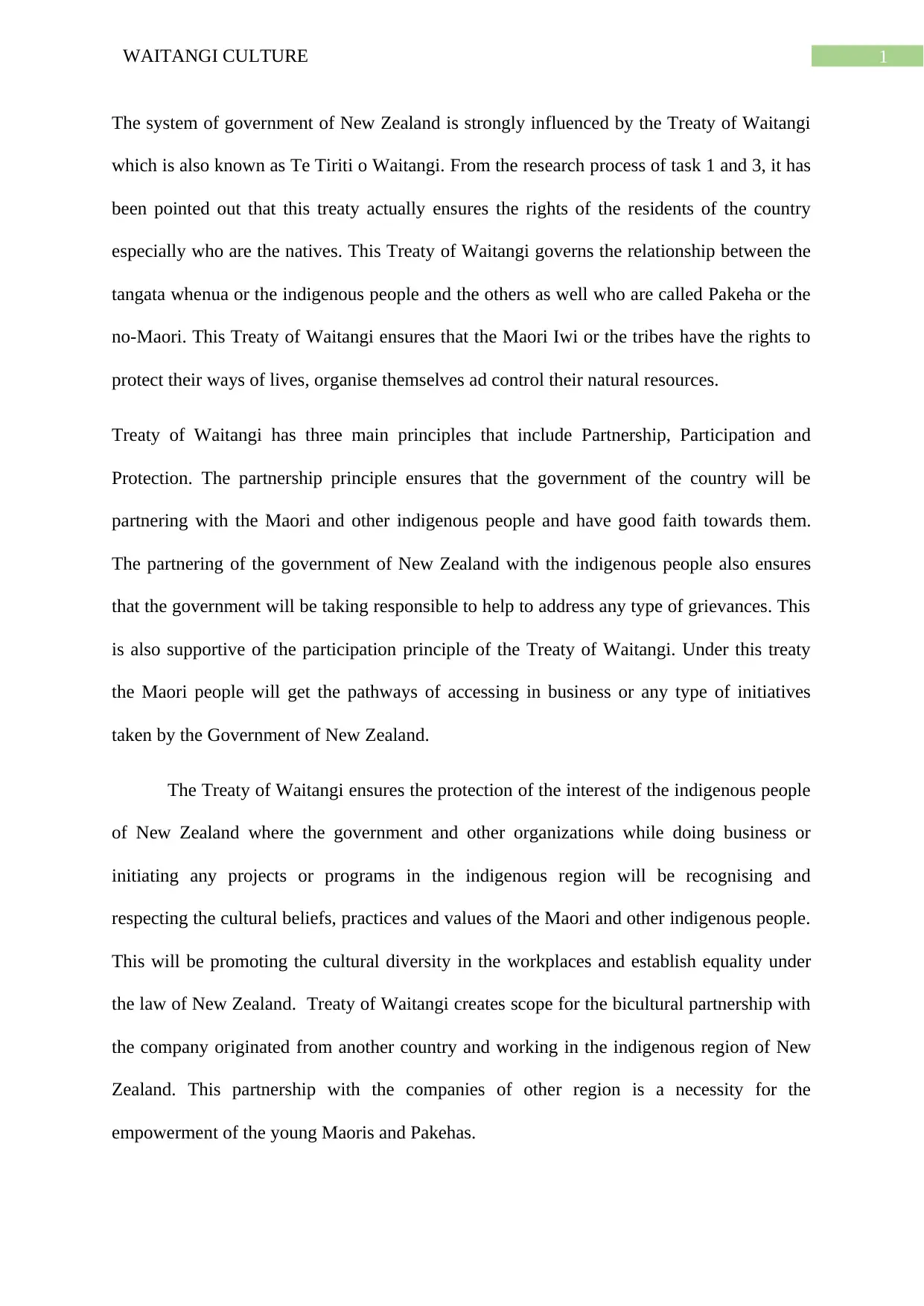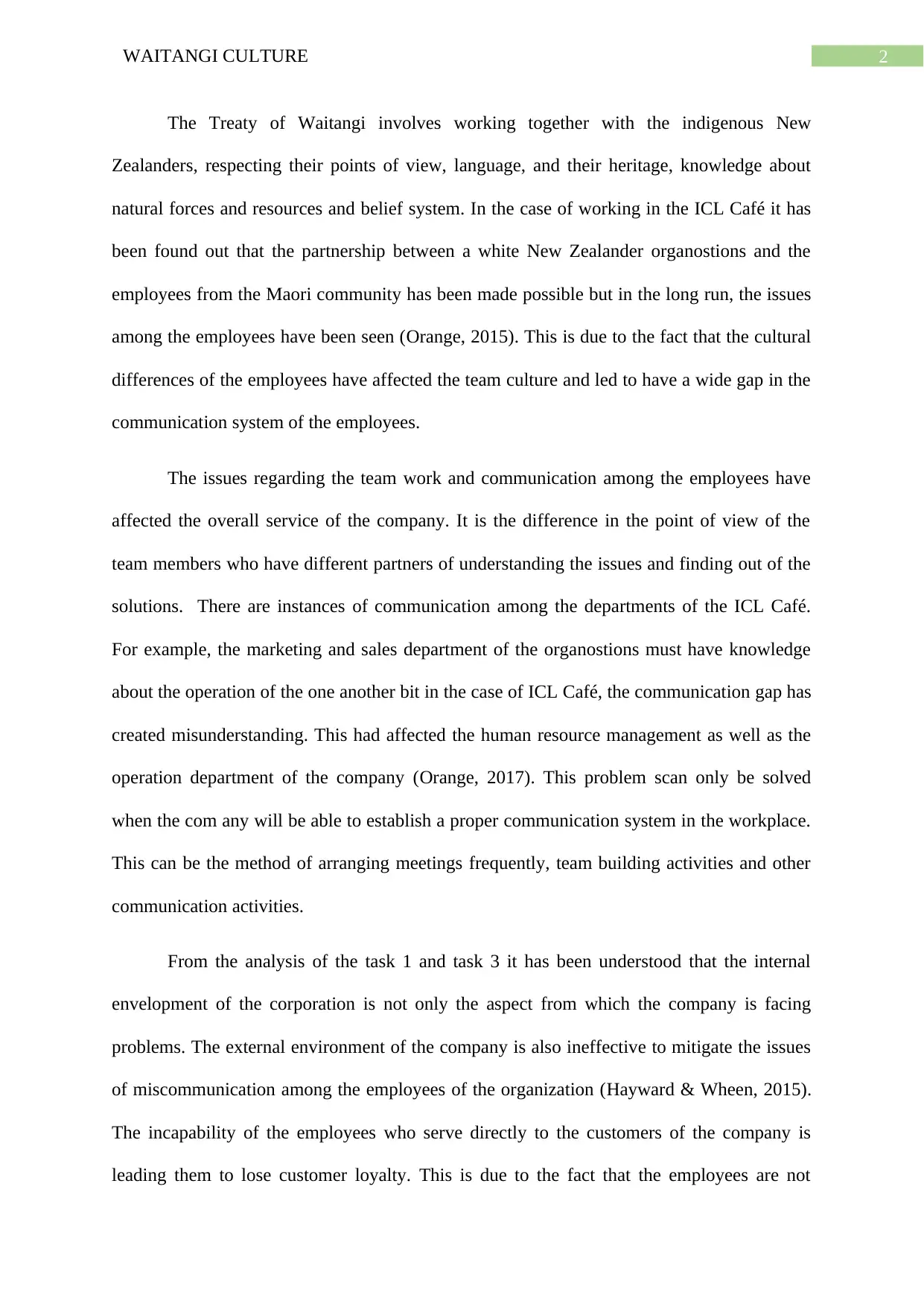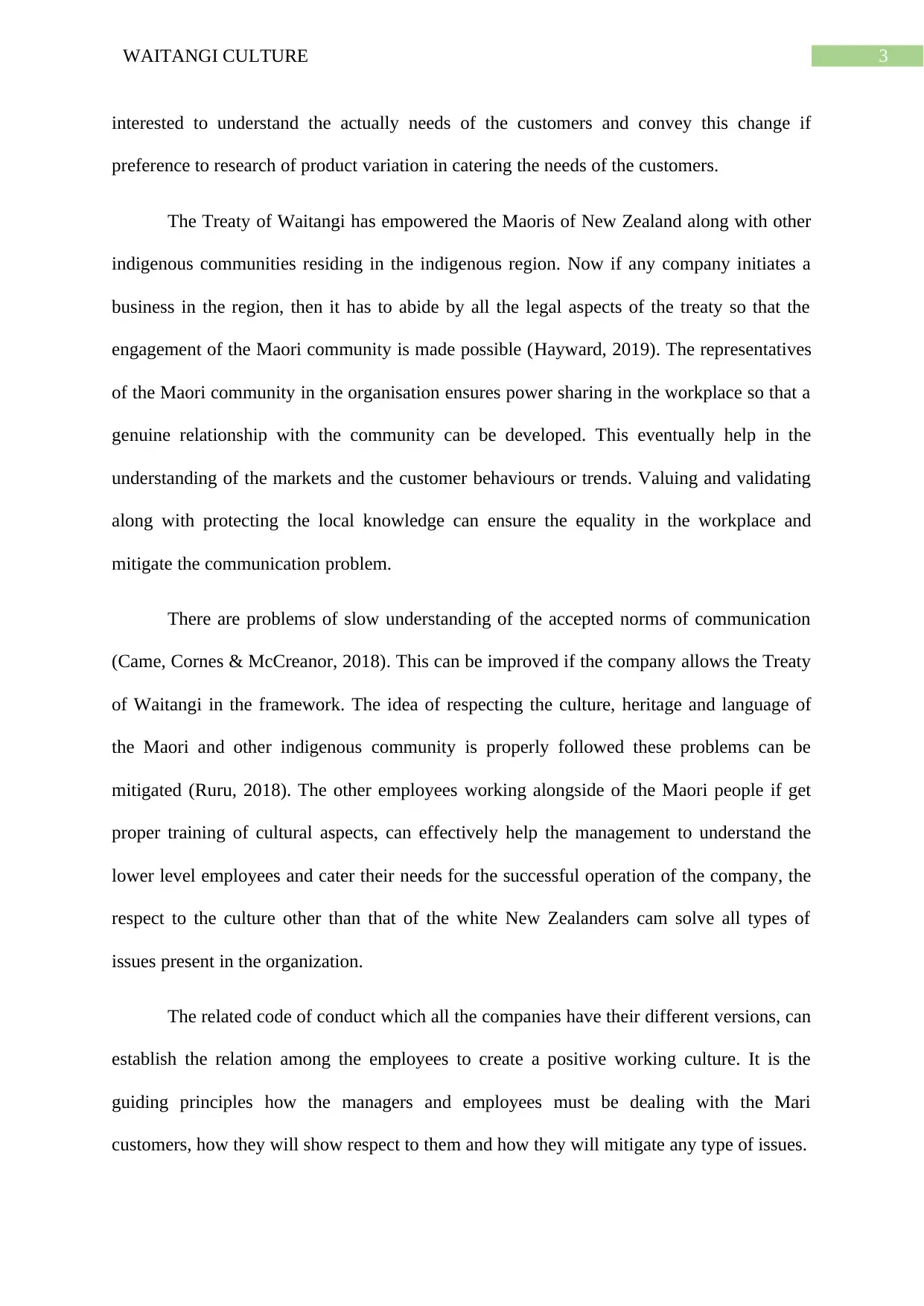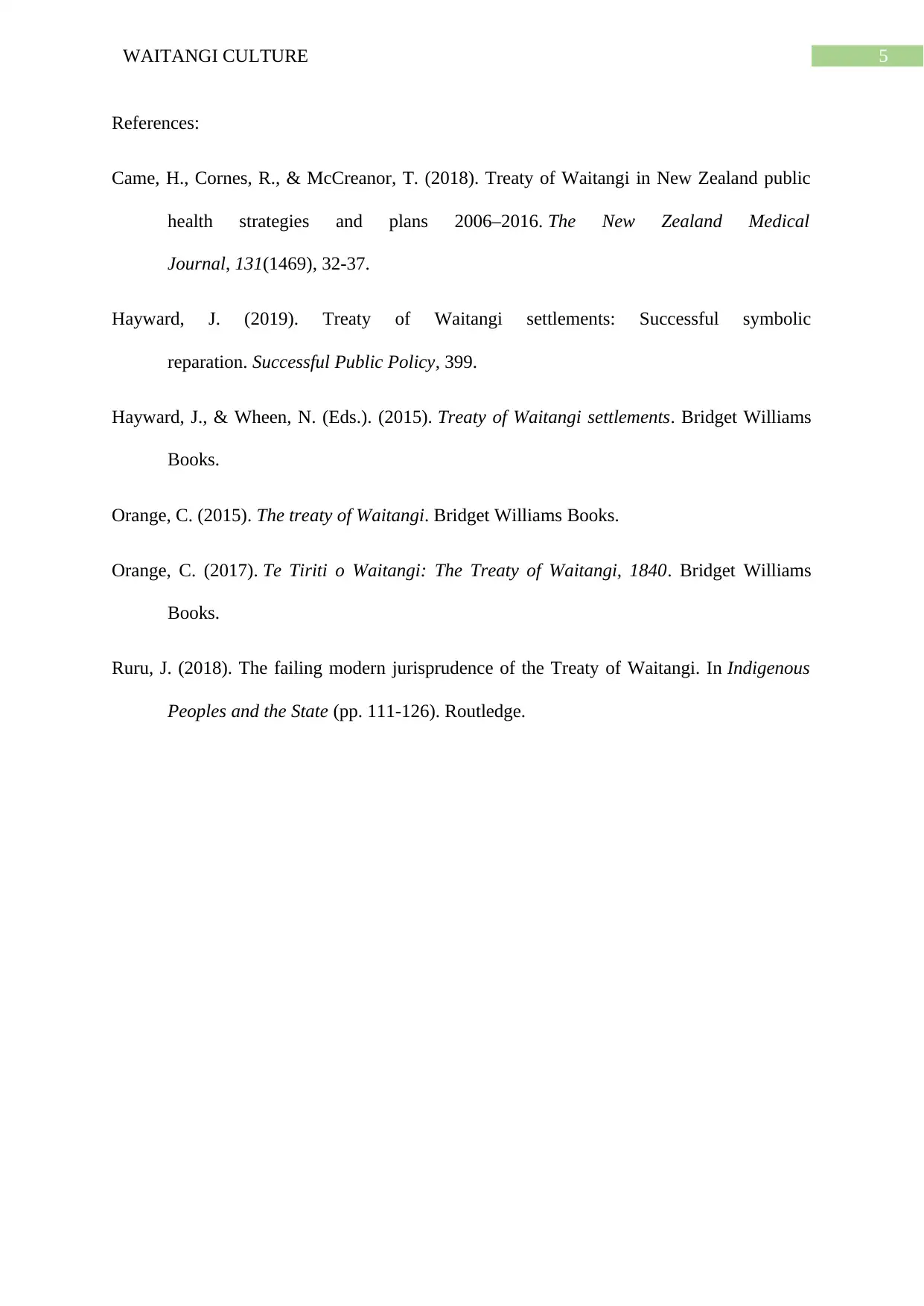Analysis of Treaty of Waitangi's Impact on Business Activities
VerifiedAdded on 2022/11/18
|6
|1273
|474
Report
AI Summary
This report delves into the influence of the Treaty of Waitangi, also known as Te Tiriti o Waitangi, on business practices in New Zealand. It explores the treaty's principles of Partnership, Participation, and Protection, emphasizing their significance in governing relationships between the indigenous Maori people (tangata whenua) and non-Maori (Pakeha). The analysis highlights how the treaty ensures Maori rights to cultural preservation, resource control, and participation in business, while also addressing potential challenges in bicultural partnerships, as exemplified by the case of ICL Café. The report underscores the importance of respecting Maori cultural values, languages, and heritage to foster equality and mitigate communication issues within organizations. It also emphasizes the need for businesses to align with the treaty's principles to promote customer loyalty, empower Maori communities, and create a positive working environment. The report concludes by suggesting that embracing the Treaty of Waitangi in the workplace can effectively address communication problems and promote a more inclusive and culturally sensitive business landscape.

Running head: WAITANGI CULTURE
WAITANGI CULTURE
Name of the Student:
Name of the University:
Author Note:
WAITANGI CULTURE
Name of the Student:
Name of the University:
Author Note:
Paraphrase This Document
Need a fresh take? Get an instant paraphrase of this document with our AI Paraphraser

1WAITANGI CULTURE
The system of government of New Zealand is strongly influenced by the Treaty of Waitangi
which is also known as Te Tiriti o Waitangi. From the research process of task 1 and 3, it has
been pointed out that this treaty actually ensures the rights of the residents of the country
especially who are the natives. This Treaty of Waitangi governs the relationship between the
tangata whenua or the indigenous people and the others as well who are called Pakeha or the
no-Maori. This Treaty of Waitangi ensures that the Maori Iwi or the tribes have the rights to
protect their ways of lives, organise themselves ad control their natural resources.
Treaty of Waitangi has three main principles that include Partnership, Participation and
Protection. The partnership principle ensures that the government of the country will be
partnering with the Maori and other indigenous people and have good faith towards them.
The partnering of the government of New Zealand with the indigenous people also ensures
that the government will be taking responsible to help to address any type of grievances. This
is also supportive of the participation principle of the Treaty of Waitangi. Under this treaty
the Maori people will get the pathways of accessing in business or any type of initiatives
taken by the Government of New Zealand.
The Treaty of Waitangi ensures the protection of the interest of the indigenous people
of New Zealand where the government and other organizations while doing business or
initiating any projects or programs in the indigenous region will be recognising and
respecting the cultural beliefs, practices and values of the Maori and other indigenous people.
This will be promoting the cultural diversity in the workplaces and establish equality under
the law of New Zealand. Treaty of Waitangi creates scope for the bicultural partnership with
the company originated from another country and working in the indigenous region of New
Zealand. This partnership with the companies of other region is a necessity for the
empowerment of the young Maoris and Pakehas.
The system of government of New Zealand is strongly influenced by the Treaty of Waitangi
which is also known as Te Tiriti o Waitangi. From the research process of task 1 and 3, it has
been pointed out that this treaty actually ensures the rights of the residents of the country
especially who are the natives. This Treaty of Waitangi governs the relationship between the
tangata whenua or the indigenous people and the others as well who are called Pakeha or the
no-Maori. This Treaty of Waitangi ensures that the Maori Iwi or the tribes have the rights to
protect their ways of lives, organise themselves ad control their natural resources.
Treaty of Waitangi has three main principles that include Partnership, Participation and
Protection. The partnership principle ensures that the government of the country will be
partnering with the Maori and other indigenous people and have good faith towards them.
The partnering of the government of New Zealand with the indigenous people also ensures
that the government will be taking responsible to help to address any type of grievances. This
is also supportive of the participation principle of the Treaty of Waitangi. Under this treaty
the Maori people will get the pathways of accessing in business or any type of initiatives
taken by the Government of New Zealand.
The Treaty of Waitangi ensures the protection of the interest of the indigenous people
of New Zealand where the government and other organizations while doing business or
initiating any projects or programs in the indigenous region will be recognising and
respecting the cultural beliefs, practices and values of the Maori and other indigenous people.
This will be promoting the cultural diversity in the workplaces and establish equality under
the law of New Zealand. Treaty of Waitangi creates scope for the bicultural partnership with
the company originated from another country and working in the indigenous region of New
Zealand. This partnership with the companies of other region is a necessity for the
empowerment of the young Maoris and Pakehas.

2WAITANGI CULTURE
The Treaty of Waitangi involves working together with the indigenous New
Zealanders, respecting their points of view, language, and their heritage, knowledge about
natural forces and resources and belief system. In the case of working in the ICL Café it has
been found out that the partnership between a white New Zealander organostions and the
employees from the Maori community has been made possible but in the long run, the issues
among the employees have been seen (Orange, 2015). This is due to the fact that the cultural
differences of the employees have affected the team culture and led to have a wide gap in the
communication system of the employees.
The issues regarding the team work and communication among the employees have
affected the overall service of the company. It is the difference in the point of view of the
team members who have different partners of understanding the issues and finding out of the
solutions. There are instances of communication among the departments of the ICL Café.
For example, the marketing and sales department of the organostions must have knowledge
about the operation of the one another bit in the case of ICL Café, the communication gap has
created misunderstanding. This had affected the human resource management as well as the
operation department of the company (Orange, 2017). This problem scan only be solved
when the com any will be able to establish a proper communication system in the workplace.
This can be the method of arranging meetings frequently, team building activities and other
communication activities.
From the analysis of the task 1 and task 3 it has been understood that the internal
envelopment of the corporation is not only the aspect from which the company is facing
problems. The external environment of the company is also ineffective to mitigate the issues
of miscommunication among the employees of the organization (Hayward & Wheen, 2015).
The incapability of the employees who serve directly to the customers of the company is
leading them to lose customer loyalty. This is due to the fact that the employees are not
The Treaty of Waitangi involves working together with the indigenous New
Zealanders, respecting their points of view, language, and their heritage, knowledge about
natural forces and resources and belief system. In the case of working in the ICL Café it has
been found out that the partnership between a white New Zealander organostions and the
employees from the Maori community has been made possible but in the long run, the issues
among the employees have been seen (Orange, 2015). This is due to the fact that the cultural
differences of the employees have affected the team culture and led to have a wide gap in the
communication system of the employees.
The issues regarding the team work and communication among the employees have
affected the overall service of the company. It is the difference in the point of view of the
team members who have different partners of understanding the issues and finding out of the
solutions. There are instances of communication among the departments of the ICL Café.
For example, the marketing and sales department of the organostions must have knowledge
about the operation of the one another bit in the case of ICL Café, the communication gap has
created misunderstanding. This had affected the human resource management as well as the
operation department of the company (Orange, 2017). This problem scan only be solved
when the com any will be able to establish a proper communication system in the workplace.
This can be the method of arranging meetings frequently, team building activities and other
communication activities.
From the analysis of the task 1 and task 3 it has been understood that the internal
envelopment of the corporation is not only the aspect from which the company is facing
problems. The external environment of the company is also ineffective to mitigate the issues
of miscommunication among the employees of the organization (Hayward & Wheen, 2015).
The incapability of the employees who serve directly to the customers of the company is
leading them to lose customer loyalty. This is due to the fact that the employees are not
⊘ This is a preview!⊘
Do you want full access?
Subscribe today to unlock all pages.

Trusted by 1+ million students worldwide

3WAITANGI CULTURE
interested to understand the actually needs of the customers and convey this change if
preference to research of product variation in catering the needs of the customers.
The Treaty of Waitangi has empowered the Maoris of New Zealand along with other
indigenous communities residing in the indigenous region. Now if any company initiates a
business in the region, then it has to abide by all the legal aspects of the treaty so that the
engagement of the Maori community is made possible (Hayward, 2019). The representatives
of the Maori community in the organisation ensures power sharing in the workplace so that a
genuine relationship with the community can be developed. This eventually help in the
understanding of the markets and the customer behaviours or trends. Valuing and validating
along with protecting the local knowledge can ensure the equality in the workplace and
mitigate the communication problem.
There are problems of slow understanding of the accepted norms of communication
(Came, Cornes & McCreanor, 2018). This can be improved if the company allows the Treaty
of Waitangi in the framework. The idea of respecting the culture, heritage and language of
the Maori and other indigenous community is properly followed these problems can be
mitigated (Ruru, 2018). The other employees working alongside of the Maori people if get
proper training of cultural aspects, can effectively help the management to understand the
lower level employees and cater their needs for the successful operation of the company, the
respect to the culture other than that of the white New Zealanders cam solve all types of
issues present in the organization.
The related code of conduct which all the companies have their different versions, can
establish the relation among the employees to create a positive working culture. It is the
guiding principles how the managers and employees must be dealing with the Mari
customers, how they will show respect to them and how they will mitigate any type of issues.
interested to understand the actually needs of the customers and convey this change if
preference to research of product variation in catering the needs of the customers.
The Treaty of Waitangi has empowered the Maoris of New Zealand along with other
indigenous communities residing in the indigenous region. Now if any company initiates a
business in the region, then it has to abide by all the legal aspects of the treaty so that the
engagement of the Maori community is made possible (Hayward, 2019). The representatives
of the Maori community in the organisation ensures power sharing in the workplace so that a
genuine relationship with the community can be developed. This eventually help in the
understanding of the markets and the customer behaviours or trends. Valuing and validating
along with protecting the local knowledge can ensure the equality in the workplace and
mitigate the communication problem.
There are problems of slow understanding of the accepted norms of communication
(Came, Cornes & McCreanor, 2018). This can be improved if the company allows the Treaty
of Waitangi in the framework. The idea of respecting the culture, heritage and language of
the Maori and other indigenous community is properly followed these problems can be
mitigated (Ruru, 2018). The other employees working alongside of the Maori people if get
proper training of cultural aspects, can effectively help the management to understand the
lower level employees and cater their needs for the successful operation of the company, the
respect to the culture other than that of the white New Zealanders cam solve all types of
issues present in the organization.
The related code of conduct which all the companies have their different versions, can
establish the relation among the employees to create a positive working culture. It is the
guiding principles how the managers and employees must be dealing with the Mari
customers, how they will show respect to them and how they will mitigate any type of issues.
Paraphrase This Document
Need a fresh take? Get an instant paraphrase of this document with our AI Paraphraser

4WAITANGI CULTURE

5WAITANGI CULTURE
References:
Came, H., Cornes, R., & McCreanor, T. (2018). Treaty of Waitangi in New Zealand public
health strategies and plans 2006–2016. The New Zealand Medical
Journal, 131(1469), 32-37.
Hayward, J. (2019). Treaty of Waitangi settlements: Successful symbolic
reparation. Successful Public Policy, 399.
Hayward, J., & Wheen, N. (Eds.). (2015). Treaty of Waitangi settlements. Bridget Williams
Books.
Orange, C. (2015). The treaty of Waitangi. Bridget Williams Books.
Orange, C. (2017). Te Tiriti o Waitangi: The Treaty of Waitangi, 1840. Bridget Williams
Books.
Ruru, J. (2018). The failing modern jurisprudence of the Treaty of Waitangi. In Indigenous
Peoples and the State (pp. 111-126). Routledge.
References:
Came, H., Cornes, R., & McCreanor, T. (2018). Treaty of Waitangi in New Zealand public
health strategies and plans 2006–2016. The New Zealand Medical
Journal, 131(1469), 32-37.
Hayward, J. (2019). Treaty of Waitangi settlements: Successful symbolic
reparation. Successful Public Policy, 399.
Hayward, J., & Wheen, N. (Eds.). (2015). Treaty of Waitangi settlements. Bridget Williams
Books.
Orange, C. (2015). The treaty of Waitangi. Bridget Williams Books.
Orange, C. (2017). Te Tiriti o Waitangi: The Treaty of Waitangi, 1840. Bridget Williams
Books.
Ruru, J. (2018). The failing modern jurisprudence of the Treaty of Waitangi. In Indigenous
Peoples and the State (pp. 111-126). Routledge.
⊘ This is a preview!⊘
Do you want full access?
Subscribe today to unlock all pages.

Trusted by 1+ million students worldwide
1 out of 6
Related Documents
Your All-in-One AI-Powered Toolkit for Academic Success.
+13062052269
info@desklib.com
Available 24*7 on WhatsApp / Email
![[object Object]](/_next/static/media/star-bottom.7253800d.svg)
Unlock your academic potential
Copyright © 2020–2025 A2Z Services. All Rights Reserved. Developed and managed by ZUCOL.





